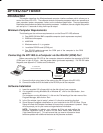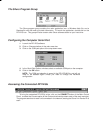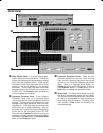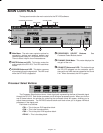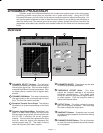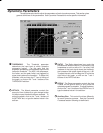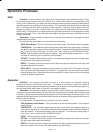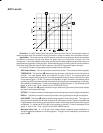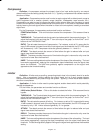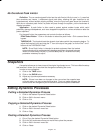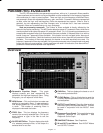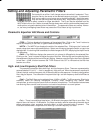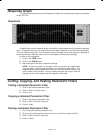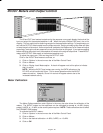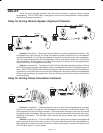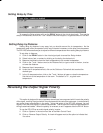15
English –
Compressor
Definiton:
A compressor reduces the dynamic level of an input audio signal by an amount
determined by the ratio setting (usually less than 10:1). Typically, a compressor has a slower reaction
time than a limiter.
Application:
Compression can be used in order to scale a signal with a wide dynamic range to
audio equipment with a smaller dynamic range (amplifier, loudspeaker, tape recorder, etc.).
Compression can also be used to improve the audio quality when a talker has a tendency to move
closer to the microphone, causing sudden shifts from quiet to loud. In this case, a compressor would
help by lowering the loud signals when the talker is closer to the microphone, creating a consistent
signal level.
For the Compressor, the parameters and controls function as follows:
COMP Select Button. Click on this button to select the compressor. Click a second time to
bypass.
THRESHOLD. The threshold sets the dynamic level above which the processing begins. To
adjust the threshold, click and drag the “T” box at the top of the graph, or click on the ↑ and ↓
buttons of the THRESHOLD field.
RATIO. The ratio sets the amount of compression. For instance, a ratio of 2:1 means that for
every 2 dB increase in dynamic level of the input signal over the threshold, the DP11EQ output
will increase only 1 dB. Compressor ratios are generally between 1.1:1 and 10:1.
ATTACK. The attack controls the amount of time before the gain is reduced after an input
signal rises above the threshold.
DECAY. The decay controls the amount of time before the gain is returned to unity once the
input level is lower than the threshold.
KNEE. The knee setting determines the abruptness of the slope of the ratio setting. The hard
knee works aggressively, applying the compression slope immediately once the signal rises
above the threshold. The soft knee gradually applies compression as the signal level
approaches the threshold setting.
Limiter
Definition:
A limiter acts as a ceiling, preventing drastic rises in the dynamic level of an audio
signal. Like a compressor, limiting reduces the output signal, but to a much greater degree.
Occasional short peaks may still pass through the system. Typically, a limiter has a faster reaction
time than a compressor
Application:
A limiter is often used to protect against sudden bursts which could potentially
damage loudspeakers.
For the Limiter, the parameters and controls function as follows:
LIM (Limiter) Select Button. Click on this button to select the limiter. Click a second time to
bypass.
THRESHOLD. The Threshold sets the dynamic level above which the processing begins. To
adjust the threshold, click and drag the “T” box at the top of the graph, or click on the ↑ and ↓
buttons of the THRESHOLD field.
RATIO. The ratio sets the amount of limiting. For instance, a ratio of 10:1 means that for every
10 dB increase in dynamic level of the input signal over the threshold, the DP11EQ output will
increase by only 1 dB. Limiter ratios are generally 10:1 or greater.
ATTACK. The attack controls the amount of time before the gain is reduced after an input
signal rises above the threshold.
DECAY. The decay controls the amount of time before the gain is returned to unity once the
input level is lower than the threshold.
KNEE. The knee setting determines the abruptness of the slope of the ratio setting. The hard
knee works aggressively, applying the slope immediately once the signal rises above the
threshold. The soft knee gradually applies limiting as the signal level approaches the threshold
setting.



